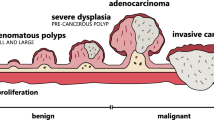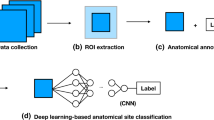Abstract
Background
A postoperative pancreatic fistula (POPF) is a critical complication of radical gastrectomy for gastric cancer, mainly because surgeons occasionally misrecognize the pancreas and fat during lymphadenectomy. Therefore, this study aimed to develop an artificial intelligence (AI) system capable of identifying and highlighting the pancreas during robot-assisted gastrectomy.
Methods
A pancreas recognition algorithm was developed using HRNet, with 926 training images and 232 validation images extracted from 62 scenes of robot-assisted gastrectomy videos. During quantitative evaluation, the precision, recall, intersection over union (IoU), and Dice coefficients were calculated based on the surgeons’ ground truth and the AI-inferred image from 80 test images. During the qualitative evaluation, 10 surgeons answered two questions related to sensitivity and similarity for assessing clinical usefulness.
Results
The precision, recall, IoU, and Dice coefficients were 0.70, 0.59, 0.46, and 0.61, respectively. Regarding sensitivity, the average score for pancreas recognition by AI was 4.18 out of 5 points (1 = lowest recognition [less than 50%]; 5 = highest recognition [more than 90%]). Regarding similarity, only 54% of the AI-inferred images were correctly differentiated from the ground truth.
Conclusions
Our surgical AI system precisely highlighted the pancreas during robot-assisted gastrectomy at a level that was convincing to surgeons. This technology may prevent misrecognition of the pancreas by surgeons, thus leading to fewer POPFs.





Similar content being viewed by others
References
Japanese Gastric Cancer Association (2011) Japanese classification of gastric carcinoma 3rd English edition. Gastric Cancer 14(2):101–12
Japanese Gastric Cancer Association (2023) Japanese gastric cancer treatment guidelines 2021 (6th edition). Gastric Cancer 26:1–25
Kobayashi N, Shinohara H, Haruta S, Ohkura Y, Mizuno A, Ueno M, et al. Process of pancreas head as a risk factor for postoperative pancreatic fistula in laparoscopic gastric cancer surgery. World J Surg. 2016;40:2194–201.
Shinohara H, Kurahashi Y, Kanaya S, Haruta S, Ueno M, Udagawa H, et al. Topographic anatomy and laparoscopic technique for dissection of no. 6 infrapyloric lymph nodes in gastric cancer surgery. Gastric Cancer. 2013;16:615–20.
Kanaya S, Haruta S, Kawamura Y, Yoshimura F, Inaba K, Hiramatsu Y, et al. Video: Laparoscopy distinctive technique for suprapancreatic lymph node dissection: medial approach for laparoscopic gastric cancer surgery. Surg Endosc. 2011;25:3928–9.
Noshiro H, Ikeda O, Urata M. Robotically-enhanced surgical anatomy enables surgeons to perform distal gastrectomy for gastric cancer using electric cautery devices alone. Surg Endosc. 2014;28(1180):1187.
Shinohara H, Kurahashi Y, Haruta S, Ishida Y, Sasako M. Universalization of the operative strategy by systematic mesogastric excision for stomach cancer with that for total mesorectal excision and complete mesocolic excision colorectal counterparts. Ann Gastroenterol Surg. 2018;2:28–36.
Hiki N, Honda M, Etoh T, Yoshida K, Kodera Y, Kakeji Y, et al. Higher incidence of pancreatic fistula in laparoscopic gastrectomy. Real-world evidence from a nationwide prospective cohort study. Gastric Cancer. 2018;21:162–70.
Suliburk JW, Buck QM, Pirko CJ, Massarweh NN, Barshes NR, Singh H, et al. Analysis of human performance deficiencies associated with surgical adverse events. JAMA Netw Open. 2019;2: e198067.
Kobayashi N, Shinohara H, Haruta S, Udagawa H, Ueno M. Reducing the risk of postoperative pancreatic fistula in radical gastrectomy: pre-assessment with computed tomography for the diagnosis of pancreatic steatosis. Langenbecks Arch Surg. 2022;407:587–96.
Ward TM, Mascagni P, Ban Y, Rosman G, Padoy N, Meireles O, et al. Computer vision in surgery. Surgery. 2021;169:1253–6.
Tokuyasu T, Iwashita Y, Matsunobu Y, Kamiyama T, Ishikake M, Sakaguchi S, et al. Development of an artificial intelligence system using deep learning to indicate anatomical landmarks during laparoscopic cholecystectomy. Surg Endosc. 2021;35:1651–8.
Kumazu Y, Kobayashi N, Kitamura N, Rayan E, Neculoiu P, Misumi T, et al. Automated segmentation by deep learning of loose connective tissue fibers to define safe dissection planes in robot-assisted gastrectomy. Sci Rep. 2021;11:21198.
Shinohara H. Surgery utilizing artificial intelligence technology: why we should not rule it out. Surg Today. 2023;53:1219–24.
Acknowledgements
We sincerely thank Editage (www.editage.jp) for English language editing.
Funding
This study was funded in part by the Japan Society for the Promotion of Science (KAKENHI grant number 19H03735, 22H03153).
Author information
Authors and Affiliations
Contributions
Study conception and design: Hisashi Shinohara, Nao Kobayashi, Yuta Kumazu, Tatsuro Nakamura; Acquisition of data: Nao Kobayashi, Kyohei Fukata, Yoshinori Ishida, Yasunori Kurahashi, Eiichiro Nakao, Yudai Hojo, Shugo Kohno, Motoki Murakami; Acquisition and interpretation of data: Hisashi Shinohara, Tatsuro Nakamura, Yuta Kumazu, Kyohei Fukata; Drafting of manuscript: Tatsuro Nakamura; Critical revision: Hisashi Shinohara.
Corresponding author
Ethics declarations
Conflicts of interest
N.K. and Y.K. are shareholders of Anaut Inc. The sponsor had no role in the study design, data collection, data analysis, manuscript preparation, or publication decisions. T.N., M.M., S.K., Y.H., E.N., Y.K., Y.I., and H.S. declare that they have no conflict of interest.
Ethical approval
The study protocol was approved by the Ethics Committee of Hyogo College of Medicine (approval number 3843). This study was conducted in accordance with the 1964 Declaration of Helsinki and its later amendments and comparable ethical standards. All patients preoperatively provided informed consent before participating in the study.
Additional information
Publisher's Note
Springer Nature remains neutral with regard to jurisdictional claims in published maps and institutional affiliations.
Supplementary Information
Below is the link to the electronic supplementary material.
Supplementary file1 (MPG 126962 kb)
Rights and permissions
Springer Nature or its licensor (e.g. a society or other partner) holds exclusive rights to this article under a publishing agreement with the author(s) or other rightsholder(s); author self-archiving of the accepted manuscript version of this article is solely governed by the terms of such publishing agreement and applicable law.
About this article
Cite this article
Nakamura, T., Kobayashi, N., Kumazu, Y. et al. Precise highlighting of the pancreas by semantic segmentation during robot-assisted gastrectomy: visual assistance with artificial intelligence for surgeons. Gastric Cancer (2024). https://doi.org/10.1007/s10120-024-01495-5
Received:
Accepted:
Published:
DOI: https://doi.org/10.1007/s10120-024-01495-5




